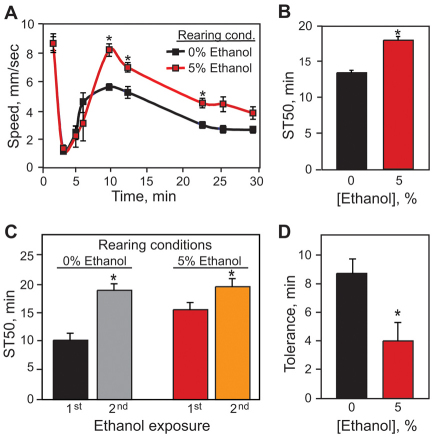Fig. 2.
Flies reared in ethanol display permanent neurobehavioral changes. (A) Ethanol-reared flies display increased locomotor hyperactivation when exposed to a moderate concentration of ethanol vapor. Flies were exposed to a 70:80 ratio of vaporized ethanol:humidified air (E/A) starting at time 0. Ethanol-reared flies achieved a peak velocity of 8.2 mm/second, compared with 5.6 mm/second for control flies (Student’s t-test, n=8, *P<0.001). (B) Ethanol-reared flies are resistant to ethanol-induced sedation. Upon exposure to a high (100:50 E/A) concentration of ethanol, control flies achieved 50% sedation 4.6 minutes sooner than ethanol-reared flies, reflecting a 34% increase in sedation resistance for flies reared on ethanol (Student’s t-test, n=12, *P<0.001). (C,D) Ethanol-reared flies are defective in tolerance development. Flies were exposed to a sedating dose of ethanol (110:40 E/A), allowed to rest for 4 hours and then exposed to a second dose; sedation times were calculated for each exposure. Control flies require an additional 9 minutes to achieve ST50 upon a second exposure, indicating the development of functional ethanol tolerance. Ethanol-reared flies develop only 4.1 minutes of tolerance (Student’s t-test, n=12, *P=0.019). In all experiments, flies were transferred as first-instar larvae to media containing 5% ethanol, collected upon eclosion, and behavioral tests were performed 2 days later.

